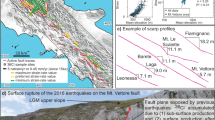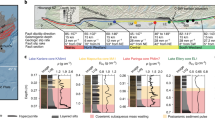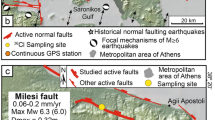Abstract
Crustal faults that produce most of their slip aseismically typically generate large numbers of small earthquakes. These events have generally been interpreted as coming from localized patches of the fault that undergo unstable (stick–slip) sliding, surrounded by larger regions of stable sliding (creep). In published catalogues the microearthquakes often appear to be distributed over large portions of the fault surface. By accurately locating large numbers of microearthquakes from faults of different orientations in California and Hawaii, we show here that instead the locations define highly concentrated streaks that are characteristically aligned in the direction of fault slip. The underlying cause of this structural organization of the fault surface remains to be determined.
This is a preview of subscription content, access via your institution
Access options
Subscribe to this journal
Receive 51 print issues and online access
$199.00 per year
only $3.90 per issue
Buy this article
- Purchase on Springer Link
- Instant access to full article PDF
Prices may be subject to local taxes which are calculated during checkout






Similar content being viewed by others
References
Scholz, C. H. The Mechanics of Earthquakes and Faulting (Cambridge Univ. Press, 1990).
Allen, C. R., St Amand, P., Richter, C. F. & Nordquist, J. M. Relationship between seismicity and geologic structure in the southern California region. Bull. Seismol. Soc. Am. 55, 753– 797 (1965).
Wallace, R. E. & Morris, H. T. Characteristics of faults and shear zones in deep mines. Pure Appl. Geophys. 124, 107–125 (1986).
Chester, F. M., Evans, J. P. & Biegel, R. L. Internal structure and weakening mechanisms of the San Andreas fault. J. Geophys. Res. 98, 771–786 (1993).
Got, J-L., Fréchet, J. & Klein, F. Deep fault plane geometry inferred from multiplet relative relocation beneath the south flank of Kilauea. J. Geophys. Res. 99, 15375–15386 ( 1994).
Dodge, D. A., Beroza, G. C. & Ellsworth, W. L. Foreshock sequence of the 1992 Landers, California earthquake and its implications for earthquake nucleation. J. Geophys. Res. 100, 9865–9880 ( 1995).
Shearer, P. M. Improving local earthquake locations using the L1 norm and waveform cross-correlation: Application to the Whittier Narrows, California, aftershock sequence. J. Geophys. Res. 102, 8269–8283 (1997).
Lees, J. M. Multiplet analysis at Coso Geothermal. Bull. Seismol. Soc. Am. 88, 1127–1143 ( 1998).
Waldhauser, F., Ellsworth, W. L. & Cole, A. Slip-parallel seismic lineations on the northern Hayward fault, California. Geophys. Res. Lett.(submitted).
Gladwin, M. T., Gwyther, R. L., Hart, R. H. G. & Breckenridge, K. S. Measurements of the strain field associated with episodic creep events on the San Andreas fault at San Juan Bautista, California. J.Geophys. Res. 99, 4559–4565 ( 1994).
Linde, A. T., Gladwin, M. T., Johnson, M. J. S., Gwyther, R. L. & Bilham, R. G. Aslow earthquake sequence on the San Andreas Fault. Nature 383, 65–68 (1996).
Johnston, M. J. S. Near-silent earthquakes on the San Andreas fault system. Eos 78, F156 (1997).
Thatcher, W., Marshall, G. & Lisowski, M. Resolution of fault slip along the 470-km-long rupture of the great 1906 San Francisco earthquake and its implications. J. Geophys. Res. 102, 5353–5367 (1997).
VanDecar, J. C. & Crosson, R. S. Determination of teleseismic relative phase arrival times using multi-channel cross-correlation and least squares. Bull. Seismol. Soc. Am. 80, 159–169 (1990).
Gillard, D., Rubin, A. M. & Okubo, P. Highly concentrated seismicity caused by deformation of Kilauea's deep magma system. Nature 384, 343–346 (1996).
Thurber, C. H.et al . Two-dimensional seismic images of the San Andreas Fault in the Northern Gabilan Range, central California: Evidence for fluids in the fault zone. Geophys. Res. Lett. 24, 1591–1594 (1997).
Eberhart-Phillips, D. & Michael, A. J. Seismotectonics of the Loma Prieta, California region determined from three-dimensional V p, V p/V s, and seismicity. J. Geophys. Res. 103, 21099–21120 (1998).
Abercrombie, R. E. The magnitude-frequency distribution of earthquakes recorded with deep seismometers at Cajon Pass, southern California. Tectonophysics 261, 1–7 (1996).
Poupinet, G., Ellsworth, W. L. & Frechet, J. Monitoring velocity variations in the crust using earthquake doublets: An application to the Calaveras fault, California. J. Geophys. Res. 102, 5719–5731 (1984).
Vidale, J. E., Ellsworth, W. L., Cole, A. & Marone, C. Variations in rupture process with recurrence interval in a repeated small earthquake. Nature 368, 624– 626 (1994).
Nadeau, R. M., Foxall, W. & McEvilly, T. V. Clustering and periodic recurrence of microearthquakes on the San Andreas Fault at Parkfield, California. Science 267, 503–507 (1995).
Beroza, G. C., Cole, A. T. & Ellsworth, W. L. Stability of coda wave attenuation during the Loma Prieta, California, earthquake sequence. J. Geophys. Res. 100, 3977–3987 (1995).
Dodge, D. A. & Beroza, G. C. Source array analysis of coda waves near the 1989 Loma Prieta, California, mainshock: Implications for the mechanism of coseismic velocity changes. J. Geophys. Res. 102, 24437–24458 (1997).
Got, J-L. & Coutant, F. Anisotropic scattering and travel time delay analysis in Kilauea volcano, Hawaii, earthquake coda waves. J. Geophys. Res. 102, 8397–8410 (1997).
Schaff, D. P., Beroza, G. C. & Shaw, B. E. Postseismic response of repeating aftershocks. Geophys. Res. Lett. 25, 4549–4552 (1998).
Delaney, P. T., Miklius, A., Arnadottir, T., Okamura, A. T. & Sato, M. Motion of Kilauea Volcano during sustained eruption from the Puu'Oo and Kupaianaha vents, 1983–1991. J. Geophys. Res. 98, 17801–17820 (1993).
Owen, S.et al. Rapid deformation of the south flank of Kilauea Volcano, Hawaii. Science 267, 1328–1332 ( 1995).
Abers, G. A., Hu, X. & Sykes, L. R. Source scaling of earthquakes in the Shumagin region, Alaska: Time-domain inversions of regional waveforms. Geophys. J. Int. 123, 41–58 ( 1995).
Power, W. L. & Tullis, T. E. The contact between opposing fault surfaces at Dixie Valley, Nevada, and implications for fault mechanics. J. Geophys. Res. 97, 15425–15436 (1992).
Dieterich, J. H. Earthquake nucleation on faults with rate and state-dependent friction. Tectonophysics 211, 149–178 (1992).
Dieterich, J. H. & Linker, M. F. Fault stability under conditions of variable normal stress. Geophys. Res. Lett. 19, 1691–1694 ( 1992).
Marone, C. Laboratory-derived friction laws and their application to seismic faulting. Annu. Rev. Earth Planet. Sci. 26, 643– 696 (1998).
Ellsworth, W. L. in Urban Disaster Mitigation (eds Cheng, F. Y. & Sheu, M.-S.) 1–14 (Elsevier, Tarrytown, New York, 1995).
Beroza, G. & Zoback, M. L. Mechanism diversity of the Loma Prieta aftershocks and the mechanics of mainshock-aftershock interaction. Science 259, 210–213 (1993).
Abercrombie, R. E. Earthquake source scaling relationships from −1 to 5 M Lusing seismograms recorded at 2.5-km depth. J. Geophys. Res. 100, 24015–24036 ( 1995).
Acknowledgements
We thank R. Abercrombie for discussions, F. Waldhauser, W. L. Ellsworth and A.Cole for a preprint of their Hayward fault relocations, and F. A. Dahlen, J. Lees and P. Shearer for comments. The figures were produced using the GMT software provided by P. Wessel and W.Smith. This work was supported by the US NSF and the US Geological Survey.
Author information
Authors and Affiliations
Corresponding author
Rights and permissions
About this article
Cite this article
Rubin, A., Gillard, D. & Got, JL. Streaks of microearthquakes along creeping faults. Nature 400, 635–641 (1999). https://doi.org/10.1038/23196
Received:
Accepted:
Issue Date:
DOI: https://doi.org/10.1038/23196
This article is cited by
-
Propagation of extended fractures by local nucleation and rapid transverse expansion of crack-front distortion
Nature Physics (2024)
-
Insight on the Crustal Stress State in Faial and Pico Islands (Azores), from Analysis of Aftershocks of the 1998 Earthquake
Pure and Applied Geophysics (2020)
-
Detection of repeating earthquakes and their application in characterizing slow fault slip
Progress in Earth and Planetary Science (2019)
-
Corrugated megathrust revealed offshore from Costa Rica
Nature Geoscience (2018)
-
Subduction megathrust creep governed by pressure solution and frictional–viscous flow
Nature Geoscience (2017)
Comments
By submitting a comment you agree to abide by our Terms and Community Guidelines. If you find something abusive or that does not comply with our terms or guidelines please flag it as inappropriate.



